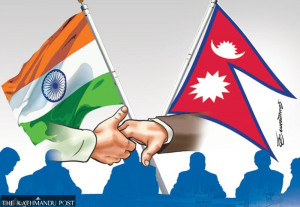Columns
The growing risks of extreme heat
The rising heat is not just a seasonal discomfort but a public health and development crisis.
Pragya Pradhan & Prabal Dahal
Earth is heating up, and there is no doubt about it. The World Meteorological Organisation reported 2024 as the warmest year ever recorded, with global temperatures reaching 1.55 degrees Celsius above pre-industrial levels. The organisation confirmed that this is the first time we have crossed the 1.5 degrees Celsius threshold in a single calendar year. The last 10 years have showcased an ongoing, alarming trend, and its impact is everywhere.
According to a 2017 study by the Department of Hydrology and Meteorology (DHM), Nepal is warming nearly twice as fast as the global average, with average temperatures rising by approximately 0.056 degrees Celsius per year. The heat will escalate if no actions are taken today.
Human cost
But heat is not just an environmental or climate issue; it has a human cost. According to the Global Heat Health Information Network, between the decades of 1990–99 and 2014–23, heat-related deaths among adults over 65 have more than doubled, underscoring the growing toll of extreme heat on vulnerable populations. Tarai is experiencing longer, deadlier heatwaves, with the 2024 heatwave causing hospital admissions to spike, stressing health systems. This can lead to increasing mortality rates if left unchecked.
The Epidemiology and Disease Control Division has also reported increased vector-borne diseases, like dengue, and their shift towards hills and mountains.
Many educational institutions across Tarai have begun shutting down schools due to extreme heat during summer. However, children in public schools are still forced to study under tin sheet classrooms, under the extreme heat. This not only affects learning but also impacts the health and well-being of the children.
The Ministry of Forest and Environment’s vulnerability and risk assessment report reveals that water scarcity is worsening, with spring discharge steadily declining in hills and mountains by 30 percent over the last three decades. Women, often caregivers, bear the brunt of walking long distances to collect water.
Similarly, according to the International Labour Organisation, 5 percent of working hours are expected to be lost annually due to heat stress in South Asia by 2030. This hampers economic productivity and deepens inequalities, as heat stress disproportionately affects the informal economy, farmers, daily wage workers and street vendors.
Urbanisation and heat
Urbanisation, a global megatrend, is crucial in heating our planet. Heavy use of concrete and asphalt, vehicles, lack of heat-reflective surfaces, reduced vegetation, and waste heat from buildings trap heat in our urban spaces. The IPCC’s Sixth Assessment Report (2022) highlighted cities’ contribution of 70 percent of global CO2 emissions. This megatrend intensifies greenhouse gas emissions, altering land surfaces and exacerbating local climate extremes such as drought and heat waves.
The Department of Hydrology and Meteorology recorded the highest temperature of 44.2 degrees Celsius in Nepalgunj in May and 35.3 degrees Celsius in Kathmandu in June 2024. A study from 2022 revealed that land surface temperatures in urban areas in Nepal are consistently greater than those in nearby rural areas. Another study from 2017 approximated a 5 degrees Celsius difference between forested and urbanised areas within the valley, indicating the urban heat island effect in Kathmandu.
A report on the degree of urbanisation in Nepal reveals that 29 percent of the country’s population is in urban areas and 40 percent in peri-urban areas. How our cities are designed has resulted in the urban heat island effect, where urban areas have significantly higher temperatures than the surrounding rural areas. This puts significant stress on energy and infrastructure, as higher temperatures mean higher electricity demand for cooling, increasing energy costs and emissions.
Heat action plan
While the impacts of extreme heat are profound, they are not insurmountable—especially when individuals, communities, civil society and governments collaborate for solutions. We must address the emerging threat of extreme heat and replicate the best adaptation and mitigation practices at scale. There is a need for a robust early warning system and preparedness, as well as effective response and anticipatory actions guided by a heat action plan.
The article particularly focuses on more forward-looking solutions through an urban planning and development approach to directly reduce the temperature and mitigate the risks of extreme heat.
A settlement-based approach—one that considers all components of a habitat as a system—could guide the way. This means looking at buildings, roads, open spaces, infrastructure, basic services and people. By understanding how these elements interact, we can identify where the challenges and vulnerabilities are concentrated and design solutions that work across these components. Integrating our efforts allows us to multiply our mitigation efforts. It puts our development decisions at the centre so that they are responsive to the risks and do not exacerbate the situation.
Protecting the natural cooling systems in our settlements—like rivers, ponds, canals, lakes, wetlands and fountains—is also essential. These features improve the microclimate, offer passive cooling and create meaningful community spaces. This means regreening and bringing in as many trees and vegetation as natural coolers. It can take several forms, such as rooftop gardens at household levels, roadside trees, shaded pathways, urban forests, pocket parks, gardens and vegetation in open spaces. Tree canopies provide shade, filter pollution and reduce surface and air temperature by natural reduction of surface temperature by up to 12 degrees.
We must also create and preserve open spaces, parks and green corridors that, combined with water bodies, create a powerful cooling synergy. Open areas can host cooling centres, water features, or shade structures that directly help people cope with extreme heat.
To reduce vehicle dependency, we must also promote the walkability of cities. Fewer vehicles mean more space for greenery and lower heat generation. We have witnessed the environmental and socio-economic benefits of a vehicle-free zone in the traditional settlement of Handigaun. While promoting walkability, permeable pavements tested in Lalitpur Metropolitan are a smart urban adaptation strategy that allows rainwater to infiltrate through surfaces, reducing runoff, recharging groundwater and significantly reducing surface temperatures.
Buildings also play a massive role in reducing heat stress and urban heat island effects. We must use passive design technology to maximise airflow. Green and cool roofs reduce the surface temperature and cool the surrounding air. For instance, Ahmedabad has successfully implemented a Heat Action Plan focused on cool roofs and early warning systems, which reduced heat-related deaths annually by approximately 1,000.
At Durga Basic School in Gadhawa Municipality, Dang—where tin-roofed classrooms used to reach temperatures as high as 45 degrees Celsius during summer—UN-Habitat tested the application of high-reflective coating that reduced indoor temperatures by up to 10 degrees Celsius. Similar affordable solutions for Nepal’s rural-urban areas can significantly improve the well-being of inhabitants and reduce energy demand.
Coordinated action
We must focus on people and communities while working on climate adaptation. To identify solutions, we must engage the vulnerable population, such as construction workers, street vendors, daily wage labourers, farmers, children, lactating mothers and persons with disabilities, ensuring their voices and needs are rightly addressed.
The bottom line is that growing heat is no longer a seasonal discomfort but a growing public health and development crisis. It demands a “whole-of-society” approach for mitigation and adaptation through coordinated action across all sectors. There is no denying that the heat is rising, and so is our awareness and ability to innovate.




 16.12°C Kathmandu
16.12°C Kathmandu
















